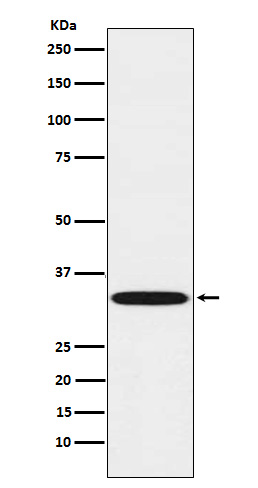TREX1 Antibody
Rabbit mAb
- 产品详情
- 实验流程
Application
| WB, IHC, IF, ICC, IHF |
|---|---|
| Primary Accession | Q9NSU2 |
| Reactivity | Human |
| Clonality | Monoclonal |
| Other Names | AGS1; AGS5; CRV; DNase III; DRN3; HERNS; TREX1; |
| Isotype | Rabbit IgG |
| Host | Rabbit |
| Calculated MW | 33212 Da |
| Dilution | WB 1:500~1:2000 IHC 1:50~1:200 ICC/IF 1:50~1:200 |
|---|---|
| Purification | Affinity-chromatography |
| Immunogen | A synthesized peptide derived from human TREX1 |
| Description | TREX1 is the major 3'->5' DNA exonuclease in human cells. The protein is a non processive exonuclease that may serve a proofreading function for a human DNA polymerase. |
| Storage Condition and Buffer | Rabbit IgG in phosphate buffered saline , pH 7.4, 150mM NaCl, 0.02% sodium azide and 50% glycerol. Store at +4°C short term. Store at -20°C long term. Avoid freeze / thaw cycle. |
| Name | TREX1 {ECO:0000303|PubMed:10391904, ECO:0000312|HGNC:HGNC:12269} |
|---|---|
| Function | Major cellular 3'-to-5' DNA exonuclease which digests single- stranded DNA (ssDNA) and double-stranded DNA (dsDNA) with mismatched 3' termini (PubMed:10391904, PubMed:10393201, PubMed:17293595). Prevents cell-intrinsic initiation of autoimmunity (PubMed:10391904, PubMed:10393201, PubMed:17293595). Acts by metabolizing DNA fragments from endogenous retroelements, including L1, LTR and SINE elements (PubMed:10391904, PubMed:10393201, PubMed:17293595). Plays a key role in degradation of DNA fragments at cytosolic micronuclei arising from genome instability: its association with the endoplasmic reticulum membrane directs TREX1 to ruptured micronuclei, leading to micronuclear DNA degradation (PubMed:33476576). Micronuclear DNA degradation is required to limit CGAS activation and subsequent inflammation (PubMed:33476576). Unless degraded, these DNA fragments accumulate in the cytosol and activate the cGAS-STING innate immune signaling, leading to the production of type I interferon (PubMed:33476576). Prevents chronic ATM-dependent checkpoint activation, by processing ssDNA polynucleotide species arising from the processing of aberrant DNA replication intermediates (PubMed:18045533). Inefficiently degrades oxidized DNA, such as that generated upon antimicrobial reactive oxygen production or upon absorption of UV light (PubMed:23993650). During GZMA-mediated cell death, contributes to DNA damage in concert with NME1 (PubMed:16818237). NME1 nicks one strand of DNA and TREX1 removes bases from the free 3' end to enhance DNA damage and prevent DNA end reannealing and rapid repair (PubMed:16818237). |
| Cellular Location | Nucleus. Cytoplasm, cytosol. Endoplasmic reticulum membrane; Peripheral membrane protein. Note=Retained in the cytoplasm through the C-terminal region (By similarity). Localization to the endoplasmic reticulum membrane is required to direct TREX1 to ruptured micronuclei (PubMed:33476576). In response to DNA damage, translocates to the nucleus where it is specifically recruited to replication foci (PubMed:16818237). Translocation to the nucleus also occurs during GZMA-mediated cell death (PubMed:16818237) {ECO:0000250|UniProtKB:Q91XB0, ECO:0000269|PubMed:16818237, ECO:0000269|PubMed:33476576} |
| Tissue Location | Detected in thymus, spleen, liver, brain, heart, small intestine and colon. |
Research Areas
For Research Use Only. Not For Use In Diagnostic Procedures.
Application Protocols
Provided below are standard protocols that you may find useful for product applications.
终于等到您。ABCEPTA(百远生物)抗体产品。
点击下方“我要评价 ”按钮提交您的反馈信息,您的反馈和评价是我们最宝贵的财富之一,
我们将在1-3个工作日内处理您的反馈信息。
如有疑问,联系:0512-88856768 tech-china@abcepta.com.
¥ 1,500.00
Cat# AP91787























 癌症的基本特征包括细胞增殖、血管生成、迁移、凋亡逃避机制和细胞永生等。找到癌症发生过程中这些通路的关键标记物和对应的抗体用于检测至关重要。
癌症的基本特征包括细胞增殖、血管生成、迁移、凋亡逃避机制和细胞永生等。找到癌症发生过程中这些通路的关键标记物和对应的抗体用于检测至关重要。 为您推荐一个泛素化位点预测神器——泛素化分析工具,可以为您的蛋白的泛素化位点作出预测和评分。
为您推荐一个泛素化位点预测神器——泛素化分析工具,可以为您的蛋白的泛素化位点作出预测和评分。 细胞自噬受体图形绘图工具为你的蛋白的细胞受体结合位点作出预测和评分,识别结合到自噬通路中的蛋白是非常重要的,便于让我们理解自噬在正常生理、病理过程中的作用,如发育、细胞分化、神经退化性疾病、压力条件下、感染和癌症。
细胞自噬受体图形绘图工具为你的蛋白的细胞受体结合位点作出预测和评分,识别结合到自噬通路中的蛋白是非常重要的,便于让我们理解自噬在正常生理、病理过程中的作用,如发育、细胞分化、神经退化性疾病、压力条件下、感染和癌症。






